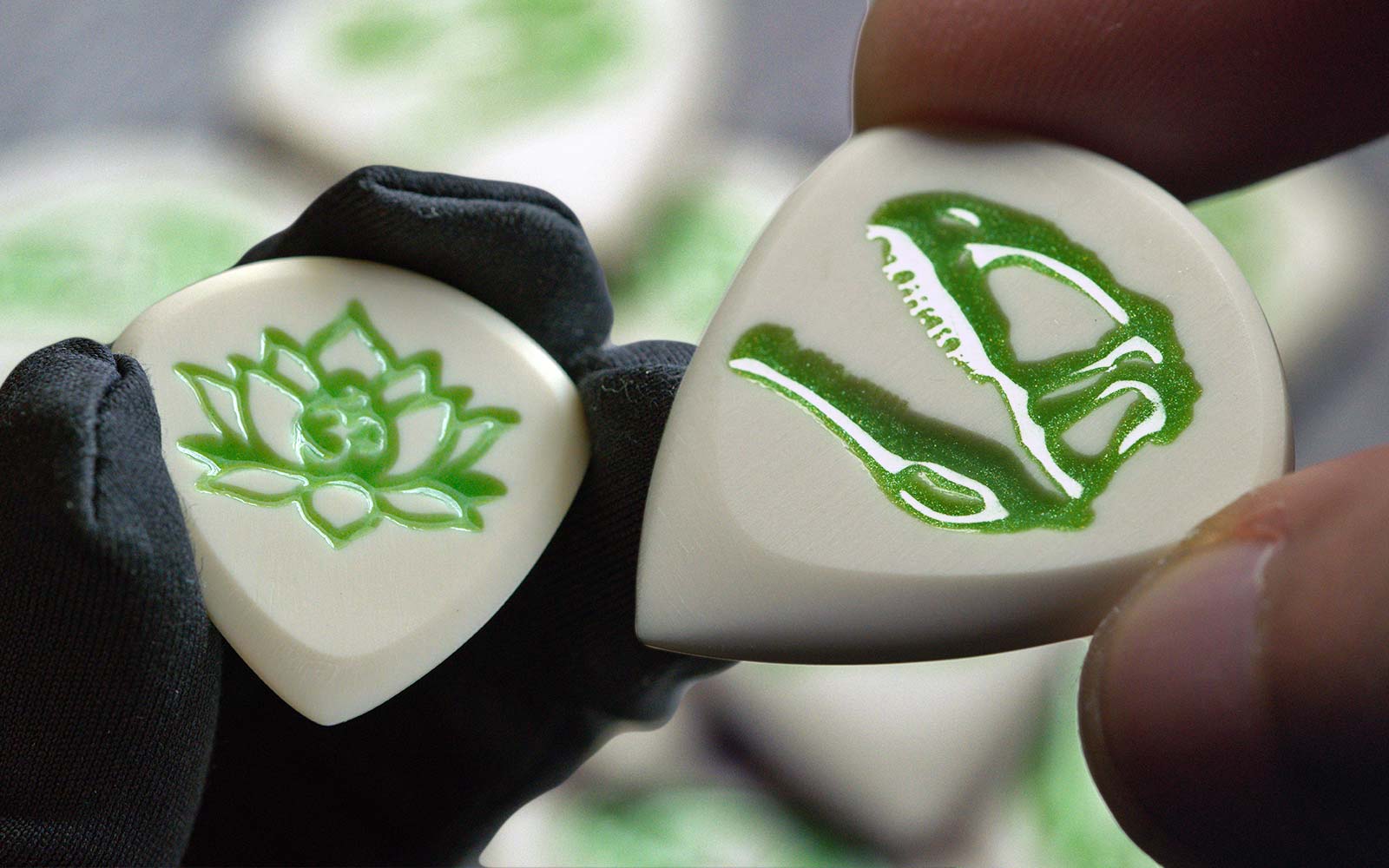Guitar String Names & How To Memorize Them
by Alex Rodea March 05, 2025
Learning each corresponding letter or name for guitar strings is an essential first step for any aspiring guitarist.
It might sound difficult to learn names for all six strings but in reality, it’s very easy and you will soon remember them.
And when you know what note is on each string and what note is on different frets, it makes learning songs much easier.

The 6 Guitar String Names
First of all, to master the fretboard and learn every note name on different frets, you need to know all six string notes.
So, here are the notes on a six-string guitar, in E standard tuning, from first to sixth string (thinnest to thickest):
-
E (high e)
-
B
-
G
-
D
-
A
-
E (low e)
Knowing these string names is essential for recognizing chord structures, scale patterns, and navigating the fretboard efficiently. It also forms the basis for tuning and transposing, which are crucial skills as you advance on the guitar.
How To Remember The Guitar Strings Order & Names
A great way to remember the names of the guitar strings is by using a mnemonic device. One of the most popular examples is "Eddie Ate Dynamite, Good Bye Eddie," where each word corresponds to the first letter of each string's name from the high E to the low E.
Another effective mnemonic is "Elephants And Donkeys Grow Big Ears," which serves the same purpose, helping you link the string names in a memorable way.
Mnemonics work because they create a mental shortcut, allowing your brain to associate the string names with vivid, easy-to-remember phrases. Repeating the phrase while tuning or playing can further solidify the connection.
In time, you’ll find that recalling the string names becomes second nature, making it much easier to focus on learning chords and scales as you progress. After all, it’s just six strings, and with a little practice, you’ll have them memorized in no time!
Related: Guitar Tuning Basics - All You Need To Know

Learn String Notes On Fretboard
However, knowing only open string notes is not enough. Having a great guitar or amplifier is great but you should know notes on the whole fretboard in order to become a great guitar player.
When you master the fretboard, you will always know what notes are you playing which makes everything easier and also helps your ear to remember different voicings of certain notes.
But it’s not that easy to know every note of all strings on every fret. But there is a great method that will help you to remember the notes.
However, first here are all the notes for each string from the open to the 12th fret:
-
1st: E, F, F#/Gb, G, G#/Ab, A, A#/Bb, B, C, C#/Db, D, D#/Eb, E
-
2nd: B, C, C#/Db, D, D#/Eb, E, F, F#/Gb, G, G#/Ab, A, A#/Bb, B
-
3rd: G, G#/Ab, A, A#/Bb, B, C, C#/Db, D, D#/Eb, E, F, F#/Gb, G
-
4th: D, D#/Eb, E, F, F#/Gb, G, G#/Ab, A, A#/Bb, B, C, C#/Db, D
-
5th: A, A#/Bb, B, C, C#/Db, D, D#/Eb, E, F, F#/Gb, G, G#/Ab, A
-
6th: E, F, F#/Gb, G, G#/Ab, A, A#/Bb, B, C, C#/Db, D, D#/Eb, E
But that’s not the best way to remember them because there are too many notes. But if you know the first string, you know the sixth string because both are E.
And to easily learn notes on the fretboard is using octave chords. An octave chord is when you play the same note octave apart.
On guitar, it’s very easy to make an octave chord. Just fret the desired note with the index finger, leave one fret and one string, and fret the note with the ring finger. That’s an octave and you play the same note.
For example, a note of the fifth fret on the sixth string is A. If you play the seventh fret on the fourth string, it’s A too. So, you play two A notes octave apart. You can do it for the fifth string too.
Now, if you learn notes on the sixth and fifth strings, you can easily find the note of other strings with the help of octave chords.

Frequently Asked Questions
What are the 6 strings on a guitar called?
The 6 strings on a guitar are typically named as follows, starting from the thinnest string:
- E string (also known as the high E string)
- B string
- G string
- D string
- A string
- E string (also known as the low E string)
The strings are typically referred to by their name or number in musical notation.
Which string has the highest pitch?
The guitar string that has the highest pitch is the thinnest string, also known as the first string or high E string. It is typically tuned to the highest pitch among all the strings on a guitar in standard tuning, which is E4 (approximately 329.63 Hz). This string is located closest to the ground when a guitar is held in playing position, and is usually the one with the lowest tension and smallest diameter. When plucked or struck, it produces a high-pitched sound that is useful for playing melodies and solos on the guitar.
Which guitar strings are easiest to play?
The easiest guitar strings to play depend on personal preference and playing style. Generally, lighter gauge strings with thinner diameters are easier to play because they require less finger pressure to fret and bend.
Light gauge strings are typically easier to play for beginners or those with weaker hand strength. These strings have smaller diameters and lower tension, which makes them easier to press down and fret, resulting in less finger fatigue. However, they may produce a less full and less loud sound than heavier gauge strings.
On the other hand, heavier gauge strings with thicker diameters and higher tension may be harder to play initially, but they can produce a fuller and louder sound with more sustain. They may also be preferred by players who play with more force and attack, or who want to achieve a specific tone or style.
What is a 7 string guitar called?
Typically these guitars have an extended range due to the extra low string. For this reason, they are sometimes referred to as "ERG" guitars which is a term that includes any guitar with more than six strings.

Conclusion
Learning the names of the guitar strings and their corresponding notes is a crucial first step for any guitarist. By memorizing the notes on each string in standard E tuning, beginners can begin to familiarize themselves with the instrument and prepare themselves for more advanced playing techniques. Also, using the octave chord makes it much easier to master the fretboard.
Also in Iron Age || General Blog

The 3 Best Engraved Guitar Picks to Personalize Your Playing Experience
by Alex Rodea March 20, 2025
Engraved guitar picks add both style and function, offering extra grip and a personal touch with custom initials, logos, or messages. Whether you're looking for a unique gift or a pick that stands out, check out our top choices and grab your first engraving for free with code...

Guitar Jack Not Working? Here's A Few Easy Steps To Fix Crackles & Pops
by Alex Rodea March 19, 2025

Mono vs Stereo Jacks: Key Differences & How to Wire Them
by Alex Rodea March 06, 2025

The Best Acoustic Guitar Picks: Tips & Considerations For Newbies
by Alex Rodea March 06, 2025

The Best Guitar Picks For Bass: A Guide To Help You Choose
by Alex Rodea March 05, 2025

What is a Fret Wrap, String Muter, or String Dampener?
by Alex Rodea March 05, 2025
+Iron Age Blogs
For the latest news & announcements, check out our News & Updates Blog
For tips, tricks, & other informative articles, check out our General Guitar Blog
Become a newsletter subscriber to get the latest info on new blog articles, receive exclusive promo codes, and be notified of upcoming giveaways!
+Recent Articles
-
The 3 Best Engraved Guitar Picks to Personalize Your Playing Experience
March 20, 2025
-
Guitar Jack Not Working? Here's A Few Easy Steps To Fix Crackles & Pops
March 19, 2025
-
Mono vs Stereo Jacks: Key Differences & How to Wire Them
March 06, 2025
-
The Best Acoustic Guitar Picks: Tips & Considerations For Newbies
March 06, 2025
-
The Best Guitar Picks For Bass: A Guide To Help You Choose
March 05, 2025
-
What is a Fret Wrap, String Muter, or String Dampener?
March 05, 2025
-
Guitar String Names & How To Memorize Them
March 05, 2025
-
How To Make Wooden Guitar Picks: Ebony Spearhead
March 05, 2025
-
Top 3 Best Guitar Picks For Grip: Iron Age Edition
March 05, 2025
-
Are Guitar Picks Necessary? Exploring the Pros, Cons, and Playing Styles
March 05, 2025
+Affiliate Notice
Iron Age is a participant in the Amazon Services LLC Associates Program, an affiliate advertising program designed to provide a way for websites to earn advertising revenues by advertising and linking to Amazon.com
Iron Age Guitar Accessories
226 Douglas Way St
San Antonio, TX 78210
USA
⚔️
“Quality is never an accident. It is always the result of high intention, sincere effort, intelligent direction and skillful execution. It represents the wise choice of many alternatives.”
~William A. Foster (MOH Recipient, 1945)
Sign up for the Iron Age newsletter to Save 15% on your 1st order, plus get exclusive offers, product updates, and early access to giveaways!
© 2025 Iron Age Guitar Accessories.
Est 2015.


Alex Rodea
Author
Founder of Iron Age, my guitar journey began in 2006, fueling a passion for crafting premium guitar accessories that embody timeless style & innovative expression. Through my Stay Tuned Guitar site I also share tips & info for new guitarists, offering everything from beginner tutorials to DIY tips & general music knowledge.